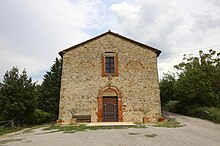Lisciano Niccone
| Lisciano Niccone | ||
|---|---|---|

|
|
|
| Country | Italy | |
| region | Umbria | |
| province | Perugia (PG) | |
| Coordinates | 43 ° 15 ' N , 12 ° 9' E | |
| height | 314 m slm | |
| surface | 35.52 km² | |
| Residents | 600 (Dec. 31, 2019) | |
| Population density | 17 inhabitants / km² | |
| Post Code | 06060 | |
| prefix | 075 | |
| ISTAT number | 054025 | |
| Popular name | Liscianesi | |
| Patron saint | San Benedetto (March 21) | |
| Website | Municipality of Lisciano Niccone | |
 Panorama of Lisciano Niccone |
||
Lisciano Niccone is an Italian commune with 600 inhabitants (as of December 31, 2019) in the province of Perugia in the Umbria region .
geography
The community extends over around 36 km² . The municipality is located about 25 km northwest of Perugia at the foot of Monte Castiglione (802 m) and on the Niccone River , a tributary of the Tiber , between Lake Trasimeno and the Tiber Valley (Valtiberina).
The districts (Frazioni) include Crocicchie, Gosparini, Le Crete, Le Crocicchie, Pian di Marte, Reschio, San Martino, Santa Maria delle Corti and Val di Rose.
The neighboring municipalities are Cortona ( AR ), Passignano sul Trasimeno , Tuoro sul Trasimeno and Umbertide .
history
Some of the districts were already inhabited by the Etruscans , as finds at Villa Sagraia and Bellona on Monte Murlo (818 m, near Preggio near Umbertide ) show. After the Battle of Lake Trasimeno in 217 BC The place was badly damaged by the troops of Hannibal . The main part of the place name probably comes from the Roman name Lisus or Licius , the name affix Niccone arose from the river of the same name in the local area. The district of Niccone near the mouth of the Niccone River in the Tiber, however, belongs to the municipality of Umbertide. During the period under Byzantine rule, the so-called Corridoio bizantino (Byzantine Corridor), a fortified corridor from Rome to the Exarchate of Ravenna , was created to protect itself from the eastern Spoleto and the western territories of the Lombards . Here there were pairs of castles facing each other, in the municipality of Lisciano Niccone these were the castles of Pierle and Lisciano as well as Reschio and Sorbello . In 1202, the Counts Del Monte of Castello di Lisciano submitted to the rule of Perugia , who at that time were under the Papal States and built the city walls between the 12th and 14th centuries. After a short time under the rule of the Casali di Cortona from the nearby Cortona, the place returned to the Papal States in 1479, where it remained until the unification of Italy in 1861. From this point in time to the 1950s, an average of around 2000 inhabitants lived in the village, after which there was a decline in population, so that today only about a third of the population of that time lives in the village.
Attractions
- Borgo di Bastia Creti , formerly called Bastia di Croce , fortified place about 8 km from the main town, which was built in 1433.
- Castello di Lisciano , a castle built in the 9th or 10th century near the main town.
- Castello di Montalto , about 18 km from the main town. First documented in 1385 when Perugia was expanding the fortress.
- Castello di Pierle , about 3 km from the main town located castle ruins on Monte Maestrino in the municipality of Cortona, which belonged to the Counts of Del Monte since the 11th century . The castle was given to the Oddi from Perugia as a fief by Bernabò Visconti in the 14th century and then acquired by the Casali from Cortona. Francesco Casali renovated the castle in 1371, but it was destroyed in 1574 on the instructions of Ferdinando I de 'Medici .
- Castello di Reschio , approx. 4 km from the main town, which was built in the 10th century and belonged to the Counts Del Monte from the 12th century at the latest . Inside is the Church of San Michele Arcangelo
- Castello di Sorbello , approx. 5 km from the main town located castle in Sant'Andrea di Sorbello, which lies in today's municipality of Cortona. Construction was started by Ghibellines in the 10th century , the south side was completed in the 12th century, the tower was significantly reinforced in the 13th century when Perugia Castle surrendered.
- Chiesa di San Biagio , church from the 11th century in the district of Pierle, which was rebuilt in 1505.
- Chiesa di San Niccolò , a church in the Val di Rose district, contains a work from 1515 by Eusebio di San Giorgio (* around 1465 in Perugia ; † after 1540. )
- Chiesa di San Tommaso , first mentioned in 1332.
- Chiesa di Santa Maria delle Corti , church in the main town.
literature
- Touring Club Italiano : Umbria , Milan 1999, p. 190, ISBN 88-365-2542-3
Web links
Individual evidence
- ↑ Statistiche demografiche ISTAT. Monthly population statistics of the Istituto Nazionale di Statistica , as of December 31 of 2019.
- ↑ Comuni Italiani website, accessed April 30, 2011
- ↑ Official website of the municipality , accessed on May 10, 2018 (English)
- ↑ Enciclopedie on line Treccani , accessed on May 10, 2018 (Italian)
- ↑ valledelniccone.it/CHIESA%20DI%20SAN%20TOMMASO.htm, former website of the Nicconetals, accessed on April 30, 2011, no longer available



